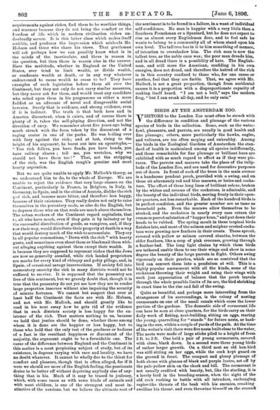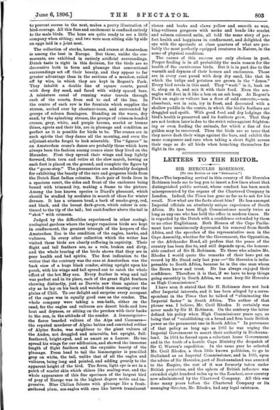BIRDS AT THE AMSTERDAM ZOO.
VISITORS to the London Zoo must often be struck with the difference in condition and plumage of the various species of birds in the collection. Some, such as the water- fowl, pheasants, and parrots, are usually in good health and fine plumage; others, more particularly the hawks, eagles, and vultures, are too often moping and unhealthy. Among the birds in the Zoological Gardens of Amsterdam the stan- dard of health is maintained among all species indifferently, and those remarkable for fine plumage or brilliant hues are exhibited with as much regard to effect as if they were pic- tures. The parrots and macaws take the place of the tulip- beds of the London Zoo, and are used for decorative purposes. out of doors. In front of each of the trees in the main avenue- is a handsome pendent perch, provided with a swing, and on, these sit alternately red and blue macaws, or lories and cocka- toos. The effect of these long lines of brilliant colour, broken by the whites and creams of the cockatoos, is admirable, and the beauty of the individual birds, moving freely in their open- air quarters, net less remarkable. Each of the hundred birds is. in perfect condition, and the greater number are as tame as household pets. Even the macaws allow themselves to be stroked, and the cockatoos in nearly every case return the common parrot salutation of "kapper krau," and put down their heads to be rubbed. The spring moult in these tropical birds finishes late, and most of the salmon and sulphur crested cocka- toos were growing new feathers in their crests. These sprout,. covered with yellow or salmon covered sheaths, between the older feathers, like a crop of pink crocuses, growing through a feather-bed. The long light chains by which these birds are tethered enable them to use their wings and show in some degree the beauty of the large parrots in flight. Others swing vigorously on their perches, which are so contrived that the bird can convert them into a pendulum at will. This is a. highly popular amusement with all the kinds, some of the cockatoos throwing their weight and using their wings with such just appreciation of balance that the perch travels through the whole possible limits of its arc, the bird shrieking in exact time to the rise and fall of the swing.
Quite as beautiful, and perhaps more interesting from the strangeness of its surroundings, is the colony of nesting cormorants on one of the small canals which cross the lower portion of the gardens. The domestic side of cormorant life can here be seen at close quarters, for the birds carry on their daily work of fishing, nest-building, sitting on eggs, rearing the young, quarrelling for " stands " for future nests, or bask- ing in the sun, within a couple of yards of the path. At the time of the writer's visit there were five nests built olose to the water. The nests were made of large sticks piled to a height of from 2 ft. to 3 ft. One held a pair of young cormorants, covered with close, black down. In a second were three young birds. of rather larger growth. On a third nest an old hen-bird was still sitting on her eggs, while the cock kept guard on the ground in front. The compact and glossy plumage of both shone with gleams of black and purple lustre, set off by the pale-yellow skin on the cheek and bill. The cormorant is not usually credited with beauty, but, like the starling, it is a lovely bird in the breeding-season, when the sight of the old cock rushing to battle with all intruders, exchanging, rapier-like thrusts of the beak with his enemies, croaking swelling his throat, and even throwing himself on the eronna
to prevent access to the nest, makes a pretty illustration of bird-courage. All this fuss and excitement is confined entirely to the male birds. The hens are quite ready to see a little company when sitting; and two were seen sitting side by side on eggs laid in a joint nest.
The collection of storks, herons, and cranes at Amsterdam is among the best in Europe. Bat these, unlike the cor- morants, are exhibited in entirely artificial surroundings. Dutch taste is right in this decision, for the birds are so decorative both in form and plumage that conventional surroundings set off their beauty, and they appear to far greater advantage than in the sections of a meadow, railed off by wire, in which they are kept in Regent's Park. They inhabit a double line of square courts, paved with deep dry sand, and faced with widely spaced bars. A miniature canal of running water travels through each of the courts, from end to end of the line. In the centre of each row is the fountain which supplies the stream, arched over by chestnut-trees, and surrounded by groups of solemn flamingoes. Standing on the warm, dry sand, by the splashing stream, the groups of crimson-headed cranes, grey, white, and purple herons, scarlet or bronze ibises, egrets and their kin, are in plumage and condition as perfect as it is possible for birds to be. The cranes are in such spirits that they dance all the morning, and even the adjutant-storks forget to look miserable. The " figures " in an Amsterdam crane's dance are probably those which have always been the fashion among cranes since they lived on the Mwander. First they spread their wings and leap lightly forward, then turn and retire at the slow march, bowing as each foot is placed on the ground, and complete the figure by the "goose-step." The pheasantries are admirably designed for exhibiting the beauty of the rare and gorgeous birds from the Dutch East Indian colonies. Each pair of birds lives in a spacious court, the sides and front of the enclosure being bound with trimmed ivy, making a frame to the picture. Among the less known species is Diard's pheasant, which should be studied by modistes in search of ideas for winter dresses. It has a crimson head, a back of smoke-grey, red, and black, and the breast dark-green, which colour is con- tinued to the tip of the tail; but each feather above the tail is shot " with crimson.
Judged by the difficulties experienced in other zoologi- zoological gardens where the larger rapacious birds are kept in confinement, the greatest triumph of the keepers of the Amsterdam Zoo is the condition of the eagles, hawks, and vultures. In every other collection which the writer has 'visited these birds are clearly suffering in captivity. Their flight and tail feathers are, as a rule, broken and dirty, and the whole bearing of the birds shows that they are in poor health and bad spirits. The first indication to the writer that the contrary was the case at Amsterdam was the back view of a huge black condor, sitting upright upon his perch, with his wings and tail spread out to catch the whole effect of the hot May sun. Every feather in wing and tail was perfect and in its place, each of the great flight feathers 'showing distinctly, just as Darwin saw them against the sky as he lay on his back and watched them soaring over the plains of Chili. To our delight and surprise every occupant of the cages was in equally good case as the condor. The whole company were taking a sun-bath, either on the sand, for the eagles and vultures are desert birds and love heat and dryness, or sitting on the perches with their backs to the sun, in the attitude of the condor. A lammergeier- the fierce bearded vulture of the Alps and Caucasus— the reputed murderer of Alpine babies and convicted robber of Alpine flocks, was neighbour to the giant vulture of the Andes, not draggled and miserable, but upright, full- feathered, bright-eyed, and as smart as a Lancer. He too spread his wings for our edification, and showed the immense length of flight feathers and the exquisite beauty of the plumage. From head to tail the liimmergeier is pencilled grey on white, the tail, unlike that of all the eagles and vultures, being long and pointed, and adding greatly to the apparent height of the bird. The fierce, light eye is set in a patch of scarlet skin which shines like sealing-wax, and the whole appearance of this fine specimen of the largest bird of prey of Europe was in the highest degree noble and im. pressive. Blue Chilian falcons with plumage like a fresh- gathered plum, sea-eagles with eyes like brown translucent stones and beaks and claws yellow and smooth as wax, king-vultures gorgeous with necks and heads like scarlet and salmon coloured satin, all told the same story of per- fect health and happiness in confinement, and delighted the eye with the spectacle at close quarters of what are pro- bably the most perfectly equipped creatures in Nature, in the acme of physical condition.
The causes of this success are only obvious in part. Proper feeding is in all probability the main reason for the health of the carnivorous birds. But it is in part due to the warmth and dryness of their houses and enclosures. These are in every case paved with deep dry sand, like that in which the tulips and potatoes are grown in the " dunes." Every bird revels in this sand. They "wash" in it, bask on it, sleep on it, and mix it with their food. Even the sea- eagles will duet in it like a hen on an ash heap. At Regent's Park an eagle or vulture has a floor of cold concrete,--non- absorbent, wet in rain, icy in frost, and decorated with a shallow puddle in the centre, in which the bird's feathers are draggled and spoilt. With good food and dry lodgings the bird's health is preserved and its feathers grow. That they are not broken later is due to the strict rules against frighten- ing or even feeding the animals, for which a fine of five gulden may be recovered. Thus the birds are so tame that they never dash their wings against the bars, and exhibit the same composure and care when taking a abort flight across their cage as do all birds when launching themselves for flight in the open.







































 Previous page
Previous page